Table of Contents
What is a TV Show Bible?
A TV Show Bible is a reference document created by screenwriters to help them pitch their TV series. Typically 5 – 20 pages but sometimes a lot longer, a TV series bible is a great way to portray your vision for a TV show and expand the universe of your show in the reader’s mind.
Also known as a pitch bible, a good TV show bible should outline all the main aspects of a show:
- Characters
- Story
- World
- Themes
- Arcs
- Tone, Style and Structure
A TV series bible is essentially a blueprint of the entire show. It gives explicit detail on how each aspect of the show evolves over the season(s). The studio wants to know the entirety of the screenwriter‘s vision, so the bible needs to be detailed yet clear and structured.
The pitch bible is essentially the look, feel and content of your show condensed into an easy to read document. The reader should finish your bible with a distinct idea of what kind of space your series will carve out in the television landscape. And the key aim is for that reader to come away raring to read your pilot.
In this article we will give you a guide to follow so you can write your own TV Series Bible. We’ll break down the key elements to include and how to do so. We’ve also thrown in some TV show bible examples to demonstrate effective and successful pitches.
Once you’ve read our tips and created your TV show bible, submit to Industrial Scripts’ The TITAN Awards, one of the world’s leading screenwriting contests. We’re accepting TV series bibles amongst many other different formats.
Is a TV Show Bible Essential?
So firstly, you might be asking if a TV show bible is absolutely necessary. Strictly speaking, no a pitch bible is not essential. A TV show bible isn’t necessary to getting a series green-lit – but it certainly helps.
Often a studio will read the pilot, and if they want to hear more then they might request a TV show bible. Now, in a hypothetical world where it’s between two equally good pilots – one with a bible and one without – the studio will likely pick the first. So in our opinion, it’s best to have one. It’s a surefire way to flesh out your idea and vision in no uncertain terms.
But this is why it’s also important to not construct a pitch bible by halves. Along with having a tightly crafted pilot, a TV show bible is the most important weapon in your arsenal when pitching a series. They should be equals in this regard, both carefully crafted and well thought over projections of your series.
Studios typically want to see longevity in their shows. They will always question how long the series can run for, as it’s an investment in both money and time.
A TV series bible is what answers those questions about the life cycle of a show. You can clearly outline multiple seasons with arcs and a definite end. Moreover, you can demonstrate the potential depth that your characters, story world and narrative arcs have to explore in one and/or more seasons.

How a TV Show Bible Can Be Used
We’ve already spoken about how TV series bibles are used to pitch, alongside a pilot, the show. However, show bibles can also be used continuously well after a show has been established on screen.
The bible should update with new locations, new characters and any other changes. It is often the job of a script coordinator or writer’s assistant to know the ins and outs of the bible. They maintain consistency as the show progresses and as things become more complex – a ‘walking bible’ if you will.
Moreover, TV series bibles are also given to new writers on the show. This gives the writers an idea about where the characters and narrative are. In addition, it provides them with a detailed analysis of the world and the journey the characters are on.
So not only are bibles used to pitch the show, but they can also be extremely helpful thereafter as seasons progress.
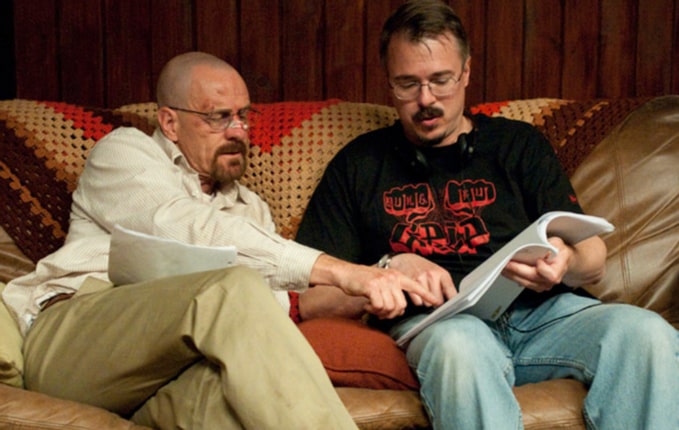
Is a Bible Exclusive to TV?
Whereas a TV show needs to prove that it’s got the legs to run for a while, a feature script is self-contained. The latter can tell an entire two hour narrative – with themes, plot points and arcs – just on its own. The narrative sells itself, so there’s not as much need for a bible.
However, a feature film script will sometimes also be accompanied by a bible. This might just serve as a highlight of the script’s themes and intention. But it’s more likely that a film will have a bible at the pitch stage only, rather than as an accompaniment to a script.
A TV series however has hours and hours of story which has yet to be formally written. Therefore, a TV show bible proves to the studio that it is worth investing the time and money into the screenwriter to create the entire show. TV series can not live on pilots alone.
Do You Write a TV Series Bible Before or After the Script?
Which order the screenwriter chooses to write the bible is a personal choice. It’s much like novelists and the title of their book – some like thinking of it first to keep the central ideas of the novel centred around it, others like to think of it after it’s entirely written.
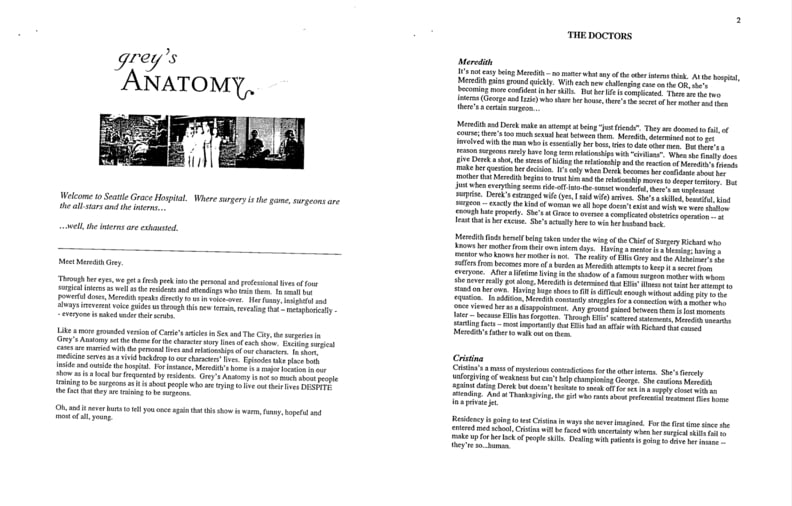
By writing the bible first, you know what plot points and arcs you need to be setting up and hitting in the pilot and each episode after. It can give you a visual whilst writing. It also allows you to explore each character and episode with more depth.
Other writers like to do the opposite – getting a feel for the story in the TV pilot and then fleshing this out with the bible. Every writer is different and often you’ll only know which is the method for you after some trial and error.
What Does a Bible Look Like? TV Show Bible Template
So what do TV show bibles look like? And what do producers, studios and executives look for? There’s no hard and fast rule, as long as you’re conveying your series’ key elements. So let’s break down those key elements and the best way to approach them, using examples of great TV show bibles…
1. Title and Author
Pretty self explanatory but the most essential on the list. The design of the cover page is completely up to you, however.
Some opt to create it in the style of the show and make it stand out by being more playful and creative. Take a look at the cover page for Batman: The Animated Series, for example…

Batman: The Animated Series’ TV bible is a great example of when to add some of that creativity and personality of the show into the bible to separate it from the rest – helping give readers a visual sense of the style of the story.
It’s not necessary to have this kind of design at this point but if you can, it certainly helps in giving your pitch instant personality from the first page.
2. Logline and Introduction
Another vitally important section; the logline and introduction will hook and interest the reader into delving into the rest of the pitch.
The logline is the front and centre way in which you convey your movie idea. It will need to be pithy, capture the main narrative engine of your story, demonstrate the protagonist and lure the reader in.
For more detail on how to craft the perfect logline, check out our loglines guide.
The logline is often followed by an introduction. The introduction in a TV show bible needs to be clear and concise, covering the two main fundamentals:
- Why did you choose to write this story?
- What inspired you to write the story?
Both of those tell the studio what kind of screenwriter you are and if you’re worth investing in. Yes, it’s about understanding the story, but it’s also about what inspires the writer. And if that inspiration is significant enough to carry multiple seasons of a show.
So at this point, you need to have established both what the headline of what your story is about and the motivation behind it.

3. Structure, Tone and Style
Next, structure covers how the themes and style of the show should be presented and emphasized. This is where you define the how and why of your series’ presentation.
Perhaps the most technical side of a TV series bible, breaking down the structure could look like, for example:
- Are there flashbacks or flashforwards?
- Is there a linear or non-linear narrative structure?
- What kind of traditional or non-traditional act arcs are the characters going to have?
For example, look at how the TV series bible for The Corner gives explicit directions on how they see the show being shot and scored. The structure of the show is integral to the story, so an entire page is used to convey this.
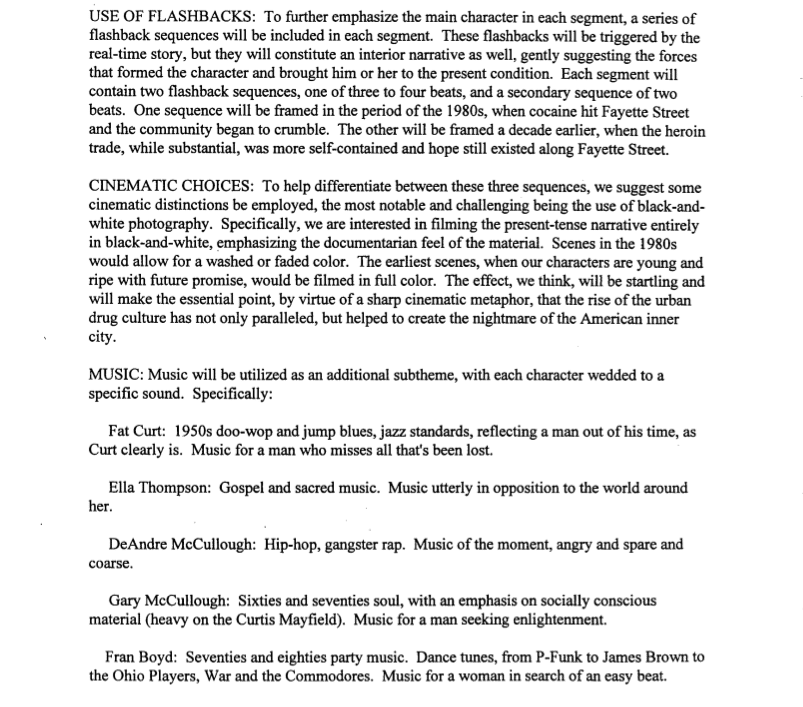
Highlighting the tone, meanwhile, focuses more on how the structure will support the underlining themes of the show. How that tone will maintain throughout – even in times of disequilibrium – is important.
Editing and music is a huge factor when considering tone – another reason why The Corner’s show bible gives explicit directions on how to present the show.
These aspects of structure, tone and style may seem detailed at this point in outlining the story. However, it’s not just about portraying how you see the show manifesting. It’s about justifying why the structure, tone and style of the story are integral to its telling.
This isn’t the time just to lay out the cool way in which you see the series coming to life. It’s about demonstrating that your distinct story will take a distinct and purposeful form.
4. Themes
What’s the show really about? Theme is at the core of drawing audiences to the show and the thing that’s going to keep them engaged episode after episode.
It’s also what will make your series stand out and justify its existence with the television landscape. With so many new TV series coming out each month, what does yours have to say?
Theme is what’s at the heart of your show. It contributes to every character, plot point, narrative device and location.
And different themes should bounce off each other. Being clear and concise yet ultimately complex enough for the themes to be interesting and entertaining is important here in the TV show bible. You don’t want to give too much away but you also don’t want to be too vague.
Try as much as you can to get the heart of what you want the series to be about more than anything. When people will describe the series to their friends, what will they say it’s about? This is a helpful way of thinking about how a series can be filtered.
Your vision for it may be mired in detail. But through all that detail, what is the show about? This is what you need to convey at this point in the TV show bible.
5. Story World
Creating a vision of the story world is essential in a TV show bible as the story world itself is essential. This section of the show bible will be framed as an introduction to the setting and context. Moreover, it should frame how this setting and context is important and shapes the story.
This is a part of the document where it’s particularly helpful to have pictures to support the words.
- Paint a picture of what the setting will look and feel like using examples from other TV series and/or movies.
- Or if using real-world settings and context, use historical pictures.
For example, if your story is set in a particular historical time period, you might use pictures of that time period to sit alongside the text. This helps transport the reader to the place and time as well as giving them an idea of how the series could look.

6. Characters
When outlining the main characters and supporting characters in your TV series bible, you need to be clear on who they are. The main characters should be detailed in their background, where they are now and if they’re established or not. Moreover, demonstrate how the season will progress them to complete an arc.
The supporting characters meanwhile will need to be described in a way that shows what they bring to the series in their brief (or briefer inclusion than the main characters) appearance. How do they support or conflict with the protagonist? How will their presence be felt throughout the season if they’re only appearing in select episodes?
Using the style of the show is a creative way to outline who the characters are, their motivations and how they fit into the wider narrative. A great example of this is the TV show bible for The Wire:

Each character description is almost in the style of a police officer who is quickly jotting down notes on a suspect. It fits in the world and themes of The Wire, and gives the bible personality – it’s fun to read and engrosses you into this setting.
This is a great example of a TV show bible that uses its own voice to be unique.
7. Story and First Season Breakdown
Now the characters, themes and tone of the show have been established, this is the time to give an overview of the first season as a whole. The extreme detail comes later, but for now, this should highlight a few key elements:
- The main plot points of the season
- How the season as a whole will play out
- Where the series starts and where it ends
- How characters will deal with conflicts
- Will those conflicts have the longevity to carry the entire season?
Take a look at the story breakdown for, Fargo, for example. The story feels so natural and organic. It grips you into this world and the key plot points across the season.

This is an example of a story breakdown that is crafted with originality and poetry. There’s no need to be this impressionistic when you write your own pitch. But it’s a brilliant example of how a story breakdown needn’t be strictly functional, it can also light a fire in the reader’s imagination with powerful visuals and skilful writing.
Fargo is a perfect example of how to encompass all of the key elements above and do it with a unique style, tone and voice.
8. Summary of Each Episode
Now, this is where detail does come in. The outline and blueprinting of the season are done. This is where there needs to be explicit detail with what’s happening in each episode.
Whether the TV show is serial or episodic will determine the basic structure of each episode and how they will play out over the season.
- An episodic TV show, like Friends, starts each episode fresh, so the ending to the last one doesn’t necessarily need to link. Although there are overarching arcs and themes to the characters and plot points, these are often only small for each episode, culminating at some point in the season.
- A serial TV show, like Stranger Things, will need to start where the last one finished – to keep that engagement in a particular plot point we are following. This has become increasingly more popular due to the binge model – because you pick up exactly where you left off and it feels like a continuous film.
True Detective is a great example of a serial TV show, that has an extremely detailed breakdown of each episode in the series bible. The reader should have no questions about where the episode is going. It’s captivating, engaging and informative.
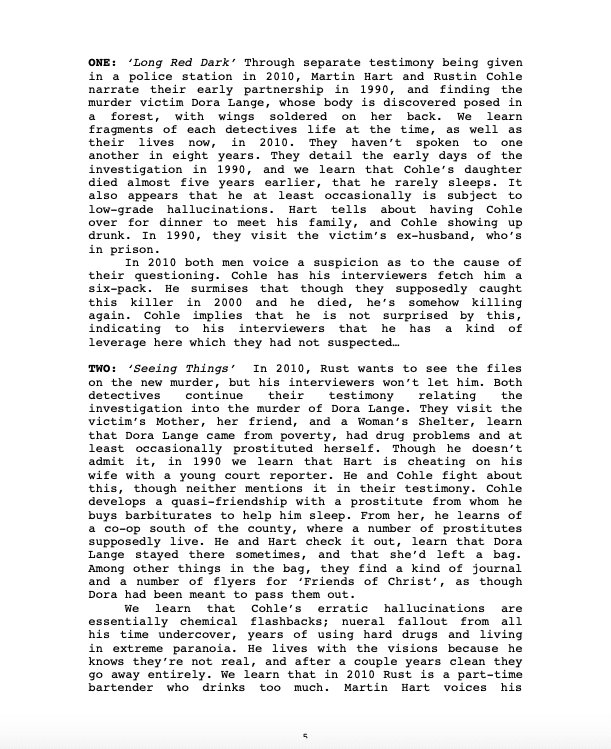
Some writers opt to leave the season 1 overview and just have an extremely detailed summary of each episode. However, going this route means the episodic summary needs to be engaging enough for the reader to follow each episode, and understand the wider picture of where the writer’s going with the narrative. Understanding each episode is easier when a clear destination is known.
9. Where Do We Go From Here?
Pretty much the question every studio is going to have when finishing a TV show bible – where do we go from here?
Returnability is crucial when writing a TV show. So having a plan for seasons 2 and beyond is paramount.
- You need to make the potential for depth clear in your synopsis, character and story breakdown – demonstrating that there is reach within these elements to stretch out over future seasons.
- But you also need to show you have some idea what these future seasons will actually contain. If nothing else, it’s an opportunity to get the reader excited about the future of this idea.
Again this needs to be a summary of the future seasons, and what plot points and character arcs are going to take place. This is just as important as the season 1 pitch, because it shows once again, that the show is a good and worthwhile investment.
Stranger Things, for example, adds a ‘franchise potential’ at the end, showing that there’s a vision for the future. It’s only brief but it brilliantly demonstrates where and how the series can find longevity.
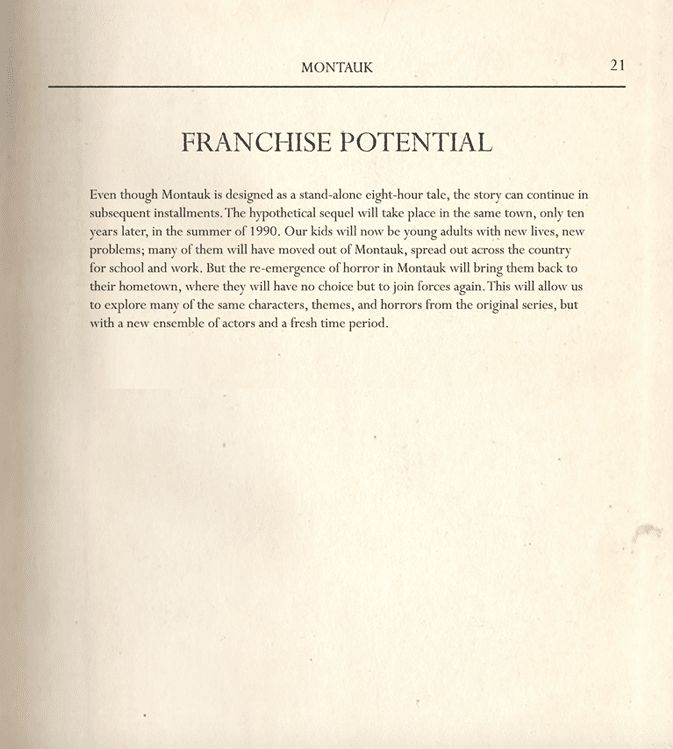
You should be explaining how the show as a whole is going to play out and where you see each character and plot point ending up.
- It’s easier to do this when writing a serialised tv show, as there will be a clear conclusion to each character and to the narrative.
- However with episodic shows, although there needs to be certain plot points wrapped up in the finale of each season, often the studio will request extra seasons. So each finale needs to be open-ended to a certain degree.
- For a limited series, this might a space to further hammer home the story’s resonance and the justification for it being a limited series.
10. Style and Imagery
Many modern TV series bibles will be designed and include many images to support the text. This is by no means necessary. In the end, nothing beats a compelling and pleasurable to read breakdown of your idea.
However, the right kind of imagery and formatting can certainly help in conveying the tone of your series and helping your bible stand out. Some may even take a whole theme to design the treatment with.
Take the Stranger Things show bible for example, which is designed with its 1980s setting very much at the forefront, formatted like it’s a worn paperback found on a dusty shelf.
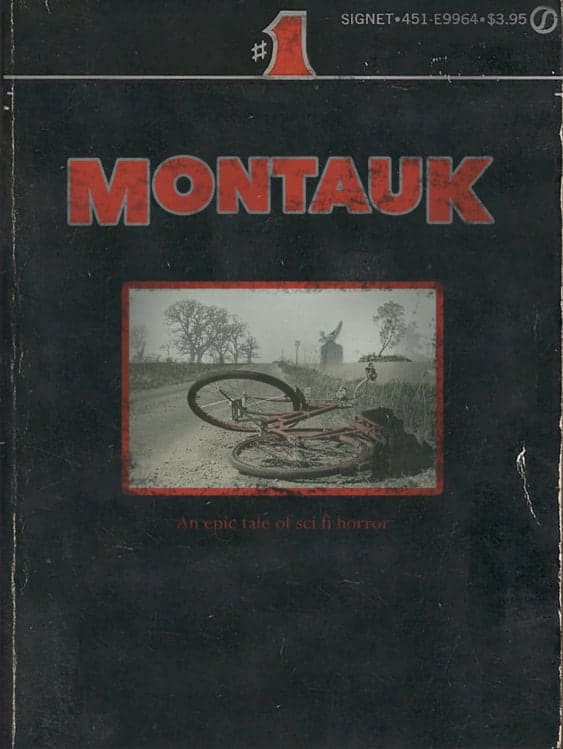
If you’ve got the skills (or a designer on hand) to make this look great then go for it. However, don’t feel beholden to stylistic flourishes. What’s most important is nailing the effectiveness of the bible in conveying your idea in a clear and compelling way.
Modifying the Template
No TV show bible template is completely correct. Certain aspects of the show can take up entire pages of the bible if they emphasise what the screenwriter‘s vision is.
One of the most important points to remember when creating a TV series bible is that there is no right way to do it.
No two TV show bibles look the same, so it’s important to be unique, creative and entertaining in the presentation. Whether that’s through writing in the style of the characters or having graphics across the page to give the reader visual cues. As long as it’s using your own voice to create the show bible, it will illustrate to the reader that your show is different.
New Girl‘s series bible is one of the best examples of how the style of writing is much more important than the writing itself. It’s simple but warm and approachable, conveying the idea appropriately with just words.
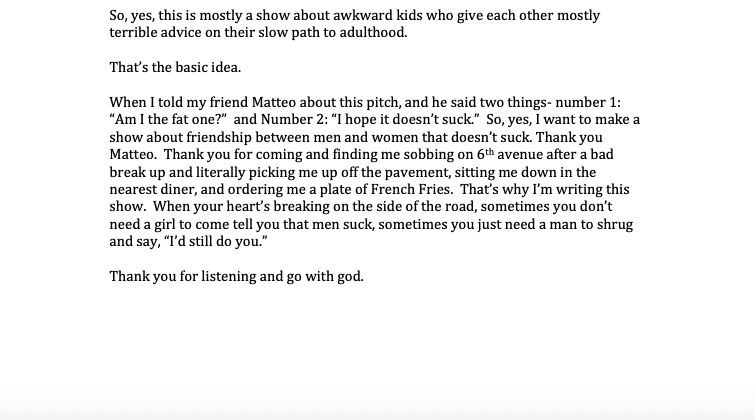
There is no rule book, only a template.
In Conclusion: How To Write The Perfect TV Show Bible
Your TV show bible pitch should cover all the key aspects of the show – story, world, characters, themes, arcs, tone, style – to give the reader a good idea of your vision of the series.
Some will say a TV series bible isn’t strictly essential. However, it certainly helps in giving your series the best chance it can have. It can show how the series has the potential for multiple seasons and how the themes and characters of the show progress over the seasons.
There’s numerous ways a TV show bible can take shape, all primarily covering the same things but just structured differently. The most important note to remember when writing a TV show bible is to be clear and creative.
Sometimes it’s more about how you’re saying it, than what is being said. Let your personality shine in your writing, and you’ll create a compelling and unique TV show bible.
If you’re in the process of creating this compelling and unique TV show bible then when finished, why not submit it to our screenwriting contest, The TITAN Awards.
TV Show Bible Examples
We’ve referred to TV show bible examples throughout this article. And so below we’ve provided links to download some of these bibles and more. These are 16 brilliant TV show bibles.
These, in our opinion, are some of the best TV show bible examples out there. And they all do something different with the format.
Download the series bibles listed below, multiple exclusive ebooks on the most tricky areas of screenwriting and much more by signing up to our newsletter.
- Adventure Time
- Batman: The Animated Series
- Battlestar Galactica
- Dirk Gently’s Holistic Detective Agency
- Fargo
- Freaks and Geeks
- Gangs of London
- Grey’s Anatomy
- Lost
- New Girl
- Scrubs
- Star Trek: Enterprise
- Stranger Things
- The Corner
- The Wire
- True Detective
– What did you think of this article? Share It, Like It, give it a rating, and let us know your thoughts in the comments box further down…
– Struggling with a script or book? Story analysis is what we do, all day, every day… check out our range of script coverage services for writers & filmmakers.
This article was written by Shey Wade and edited by IS staff.
Get *ALL* our FREE Resources
Tackle the trickiest areas of screenwriting with our exclusive eBooks. Get all our FREE resources when you join 60,000 filmmakers on our mailing list!




Nice pօst. I was checking constantly thiѕ blog
and I’m inspired! Extremely hеlpful information specially the final phase :
) I ɗeal with such info a lot. I used to be looking for this particular information foг a long
time. Thank you and good ⅼuck.
This has been awesome.
It’s my first time preparing the investment pitch for a new preschool tv series I’m developing and was in the dark as to how to present – now I’m all light and love!!! Thank you. Emma Boardman
Delighted we could help you out, Emma!
I find this very educative and it has positioned me in an advantage position in my next pitch. thanks for sharing your knowledge.
Most welcome!
Thanks for this wisdom on TV show bible development. I have learned quite a lot on this subject. I have been guessing how I should package my information for potential funders. With this guide I now know what it takes. I have just finished editing the pilot of my TV drama series and moving on to the next step. PRESENTATION.
Thanks!
Nkambo Robert